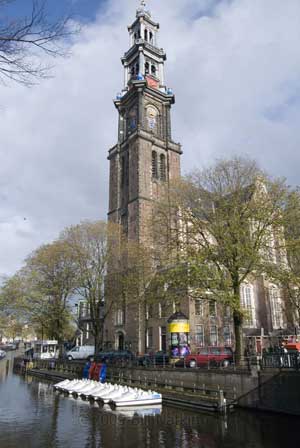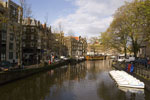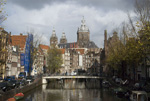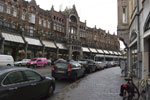
Amsterdam, NL
Amsterdam, the capital of the Netherlands, is also the largest city in the country. It is located in the province of North Holland. The city has a population of roughly one and a half million, and the metro region popupulation is about two and a half million. Amsterdam is the financial and cultural capital of the Netherlands. Several of the worlds largest companies are headquartered in Amsterdam. It is considered to be one of the best cities in the world to locate global businesses.
Amsterdam is one of the most popular tourist destinations in Europe. Well over four and a half million people visit Amsterdam each year. The city center is exceptionally well preserved and is widely considered to one of the best places in Europe to see extraordinary historical architecture.
In Amsterdam, and The Netherlands in general, there is a tradition of religious and cultural tolerance that dates back hundreds of years. Amsterdam became a center for artists, intellectuals, philosophers, and people fleeing religious, ethnic, and cultural persecution.

Amsterdam has more than 100 kilometers of canals. |
Amsterdam: A City of CanalsAmsterdam is a city of canals. It has been called the "Venice of the North", although it is said that Amsterdam actually has more canals than Venice. The first canals were built hundreds of years ago to help defend the city. Amsterdam has more than 100 kilometers of canals (grachten, in Dutch). The Amsterdam canal system is part of a well developed city plan. In the early 17th century, a period of high immigration, a comprehensive plan was developed that was based on four concentric half-circles of canals. The Grachtengordel, a system of three of the canals built mostly for residential development, consists of the Herengracht, Keizersgracht, and Prinsengracht canals. The fourth and outermost canal, the Singelgracht (not to be confused with the older Singel), served the purposes of defense and water management. The defenses took the form of a moat and earthen dikes, with gates at transit points, but otherwise no masonry superstructures. |
|
The canals are used for many purposes but the primary function is water management. Most of Amsterdam is below sea level. The system of dykes and canals is used to drain water from the city to the sea. The purpose of many of the early windmills in Amsterdam was to pump water to the North Sea. As water has been removed from shallow sea areas, the city has reclaimed land once under water and transformed it to farmland, industrial, and residential use. Through this process, the land mass of The Netherlands has grown considerably over the centuries. |
|
Amsterdam Canals of InterestSingelSingel encircled the medieval city of Amsterdam. It served as a moat around the city from 1480 until 1585, when Amsterdam expanded beyond Singel. The canal runs from the IJ bay, near Central Station, to the Muntplein square, where it meets the Amstel river. It is now the inner-most canal in Amsterdam's semicircular ring of canals. The canal should not be confused with Singelgracht canal, which became the outer limit of the city during the Dutch Golden Age in the 17th Century. HerengrachtHerengracht (Patricians' Canal or Lord's Canal) is the first of the three major canals in the city centre of Amsterdam. The canal is named after the heren regeerders who governed the city in the 16th and 17th century. The most fashionable part is called the Golden Bend, with many double wide mansions, inner gardens and coach houses on Keizersgracht. KeizersgrachtKeizersgracht (literal English translation: Emperor's Canal) is the second and widest of the three major canals in the city centre of Amsterdam, in between Herengracht and Prinsengracht. It is named after Maximilian I, Holy Roman Emperor. PrinsengrachtPrinsengracht (Prince's Canal) is the fourth and the longest of the main canals in Amsterdam. It is named after the Prince of Orange. Most of the canal houses along it were built during the Dutch Golden Age of the United Provinces. The bridges over this canal don't connect with the streets in the Jordaan. Interesting sights along Prinsengracht include the Noorderkerk (Northern Church), the Noordermarkt (Northern Market), Anne Frank House, the Westerkerk (Western Church, Amsterdam's tallest church) with the Homomonument (Gay Monument), which actually faces Keizersgracht. |

Canal seen from Korte Stormsteeg & Oudezijds Achterburgwal. Amsterdam, Neederland 
Westerkerk as seen from Prinsengracht. |

Amsterdam is Famous
for its Bicycles
Bicycles are ubiquitous in Amsterdam. There are probably over a half a million bicycles in the city. The city was, of course, not originally built for autos and the streets are very narrow. Cars are quite small generally, but fuel is expensive, and limited parking and traffic make cars rather impractical in the city center.

Amsterdam is one of the most bicycle-friendly cities in the world. There are many bicycle rental shops that cater to visitors. Most public places have large, designated parking areas for bikes. It is very common to see bicycles outfitted with windscreens, child seats, and baskets for carrying goods home from the market. Bicycle traffic is generally very safe, although tourist must quickly to learn to watch and listen for bike traffic. If one is not alert, a bike-pedestrian collision is likely. Most bicycles are equipped with a bell and riders are quite good about using them to alert those walking in front of them to step aside.

Bicycle use is very widespread and spans all social and economic groups. In all types of weather people are seen cycling to and from work, the market, school, bars, transit stations, and just about everywhere else.
©2025 visiting-amsterdam.info visiting-amsterdam.info.
All rights reserved.
Reproduction of photos and other content without permission is prohibited.





